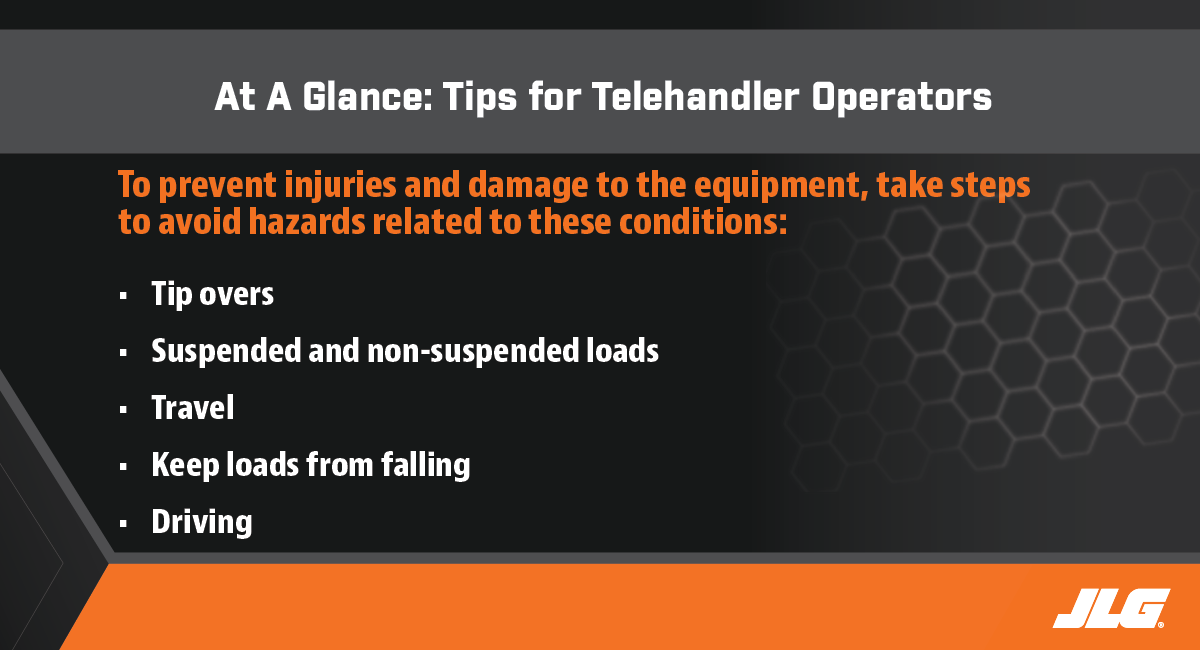 John Boehme
John Boehme
Senior Product Manager - Telehandlers
____
JLG Industries
No one plans to have an accident on the job site. The good news is that many common job site dangers can be prevented. Here are six potential hazards when operating telehandlers — and tips on how to avoid them.

Tip #1: How to Prevent Tip-Overs
Anytime an operator exceeds the maximum load or operates the telehandler in unstable or imbalanced conditions, there is a risk of a tip-over. To avoid that hazard, operators need to understand the load capacity charts for the machine and attachment and make sure that the telehandler doesn’t exceed the rated lift capacity.
Also, pay close attention to weather and job site conditions. Make sure the ground can support the machine, keep the telehandler away from holes, obstructions, drop-offs, debris or any other potential hazards and check that the wind won’t cause the load to swing.
Here are a few more ways to avoid tip overs:
- Don’t raise the boom unless the frame is level
- Lower the boom/attachment before leveling the machine
- Maintain proper tire pressure
Tip #2: How to Manage Suspended and Non-Suspended Loads
Before transporting a load, take the proper precautions to avoid issues. For example, when transporting a suspended load, tether the load to limit movement and perform operations at walking speed or slower so the load doesn’t swing. Also, keep the heaviest part of the load closest to the attachment and remember to include the weight of the rigging as part of the load.
Here are a few more things that operators avoid doing with a suspended load:
- Raising or extending the boom
- Dragging the load
- Use the machine’s frame-leveling to compensate for the load swing
With a non-suspended load, operators should not drive with the boom extended or raised above 45 degrees.
Tip #3: How to Steer Clear of Travel Hazards
Whether in a two-wheel front, four-wheel circle or four-wheel crab steer, there are travel hazards to avoid. Start by checking for adequate clearance for both rear-tail and front-fork swing, and be aware of people, machines and vehicles on the job site. If you don’t have a clear view, use a spotter. Once you’ve ensured a clear path, sound the horn.
During travel, look in the direction you’re driving, retract the boom and keep the boom/attachment as low as possible. That will help you maintain visibility of your mirrors and the path of travel.
Before going under an overhead obstruction, check the boom clearance, and position the attachment and/or load so that it clears the obstacle.
Tip #4: How to Keep Loads from Falling
No matter if operators are transporting small or large materials, they should ensure the load is properly secured and centered to prevent it from falling.
If you’re lifting a team member, only use an approved personnel work platform that has the proper capacity chart displayed in the cab. Don’t drive the telehandler when a worker is in the platform.
Tip #5: How to Drive on Slopes
Telehandlers should never be operated on excessively steep slopes or unstable surfaces to avoid tip-overs.
If an operator does need to travel on a slope, the best way to maintain the needed traction and braking capabilities is to follow these safety precautions:
- Refer to the appropriate capacity chart for the recommended travel requirements
- If the telehandler is loaded, drive with the forks pointed uphill. When it’s unloaded, keep the forks pointed downhill
- Downshift to a lower gear and use the service brake as necessary when traveling down a slope to keep from over-speeding the engine and drivetrain. Avoid engaging “inching” or shifting to “neutral” when going down a hill
- Do not park or turn on a slope
Tip #6: How to Follow Proper Operation Practices
Proper operating techniques should remain at the forefront on every job site. Operators should always refer to the Operation & Safety manuals for JLG® and SkyTrak® telehandlers to take all appropriate precautions and follow proper operating procedures. Also, be sure to ask a local equipment dealer if there are additional regulations in the area that operators need to be aware of.
To learn more about the proper operation of JLG equipment, click here.
Do you want to stay up to date with industry news and issues similar to this? Make sure you subscribe below to receive monthly updates from #DirectAccess with newly posted content so you never miss important information.